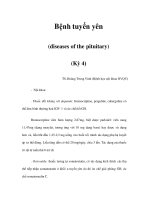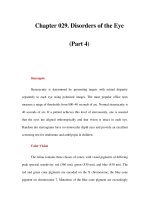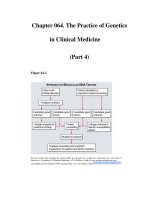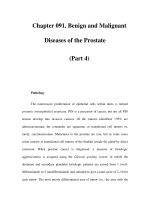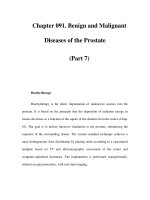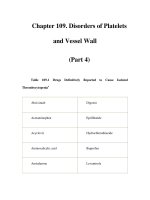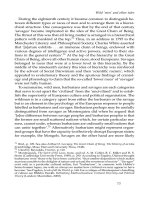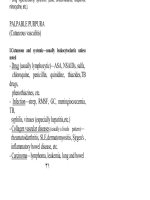Atlas of Neuromuscular Diseases - part 4 potx
Bạn đang xem bản rút gọn của tài liệu. Xem và tải ngay bản đầy đủ của tài liệu tại đây (1.02 MB, 46 trang )
137
The conus medullaris terminates at vertebrum L1. The lower segmental ventral
and dorsal lumbar and sacral nerve roots form the cauda equina.
The lumbar nerve roots run obliquely downwards and laterally. The sacral
spinal nerves divide into rami within the spinal canal. Each ramus passes
through a pelvic sacral foramen to join the sacral plexus; each dorsal ramus
emerges through a dorsal sacral foramen to supply paraspinal muscles and the
skin over the sacral and medial gluteal areas.
The cauda equina is loosely enveloped by arachnoid membrane, from which
a sleeve extends to cover each nerve root. As a nerve passes into the nerve
foramen it is invested in a short sleeve of dura.
Acute central (disc) herniation:
Pain bilaterally in the buttock, sacral, perineal, and posterior leg regions, and
sphincter dysfunction.
Chronic:
Back pain, perineal pain, paresthesias. Urinary and erectile dysfunction may
occur in men.
Acute:
Weakness of S1 and S2 muscles, sensory loss from soles to perineal region with
saddle anesthesia. Loss of anal wink.
Roots positioned most laterally (lower lumbar and upper sacral) are most
often affected, while the central roots can be spared (S3–S5). Thus, the bladder
is often spared.
Chronic:
Similar signs as acute injury.
Muscle wasting in chronic conditions may resemble chronic polyneuropathy.
Toxic:
Anesthesia (spinal and epidural anesthesia)
Contrast media
Cytotoxic drugs (intrathecal methotrexate)
Radiation: TRI (transient radicular irritation)
Spinal arachnoiditis
Genetic testing NCV/EMG Laboratory Imaging Biopsy
+++
Cauda equina
Anatomy
Symptoms
Signs
Pathogenesis
138
Vascular:
AV fistulas (spinal/dural) may mimic spinal stenosis
Cauda equina claudication
Spinal subarachnoid hemorrhage
Infectious:
AIDS: CMV infections
Herpes simplex infection
Others: cryptococcal, syphillis, tuberculosis
Inflammatory/Immune:
Bechterew’s disease
Neoplastic:
Ependymoma
Neurofibroma
Rare: dermoid, hemangioblastoma, lipoma, meningioma, paragangliomas,
schwannoma
Malignant disease: astrocytoma, bone tumors, leptomeningeal carcinomatosis,
metastases, multiple myeloma
Acute central disc protrusion:
A large acute central disc may cause acute and dramatic bilateral sciatic pain.
Also pain in the buttock and perineal regions, numbness and weakness of the
legs, and sphincter dysfunction. “Saddle anesthesia”.
Chronic central disc:
Mimics tumors of the conus medullaris and is associated with perineal pain,
paresthesias and urinary dysfunction.
Trauma:
Fractures of the sacrum
Spinal surgery
Vertebral injury
Genetic:
Tethered cord
Imaging of bony structures and MRI.
CSF in inflammatory conditions
Electrophysiology:
EMG of S1–S3 muscles
Sensory conductions
Reflex techniques (F waves, H reflex)
Spincter EMG including bulbocavernosus reflex
Magnetic stimulation
Spinal cord (epiconus- medullary lesions)
Rapidly ascending polyneuropathy
Sensorimotor neuropathies with autonomic involvement
Depends on the cause
Diagnosis
Differential diagnosis
Therapy
139
Guigui P, Benoist M, Benoist C, et al (1998) Motor deficit in lumbar spinal stenosis: a
retrospective study of a series of 50 patients. J Spinal Disord 11: 283–288
Hoffman HJ, Hendrick EB, Humphreys RB, et al (1976) The tethered spinal cord; its protean
manifestation, diagnosis and surgical correction. Childs Brain 2: 145–155
Tyrell PNM, Davies AM, Evans N (1994) Neurological disturbances in ankylosing spondyli-
tis. Ann Rheum Dis 53: 714–717
Yates DAH (1981) Spinal stenosis. J R Soc Med 74: 334–342
References
141
Mononeuropathies
143
Mononeuropathies are an essential part of clinical neurology. The clinical
diagnosis depends on the knowledge of anatomy, the presentation of clinical
syndromes and numerous etiologies.
The individual mononeuropathies of the upper extremity, the trunk and the
lower extremities are discussed by the anatomic course of the nerve , anomalies
and their symptoms and signs. The most likely causes of damage are discussed
and differential diagnosis is considered. Therapeutic aspects and if available
prognosis are mentioned.
The references are limited to a few key references. Most of our artist‘s
illustrations are devoted to this section. The clinical photography should help
the reader to identify the patient’s abnormalities.
The concept is an accurate and brief description of the most important
clinical features. The trunk nerves which are often neglected are summarized in
a separate subsection.
Introduction
145
Mononeuropathies: upper extremities
147
Genetic testing NCV/EMG Laboratory Imaging Biopsy
++
Axillary nerve
Fig. 1.
1
Axillary nerve.
2
Del-
toid muscle.
3
Teres minor
muscle
148
Symptoms
Anatomy
Fibers originate from roots of C5-C6, and travel through the upper trunk and
posterior cord of the plexus.
The nerve continues through the axilla (quadrilateral space), with a motor
branch to the teres minor and two further divisions. The posterior division
innervates the posterior head of the deltoid muscle and gives off the superior
lateral cutaneous nerve. The anterior division innervates the lateral and anterior
heads of the deltoid muscle (see Figs. 1 and 2).
Weakness in elevation of the upper arm.
Signs:
Atrophy, and flattening of the lateral shoulder.
Reduction of external rotation and shoulder adduction (teres minor muscle).
Deficits of
shoulder abduction, flexion, and extension (deltoid muscle).
Shoulder abduction is the most clinically relevant deficit, as the other muscles
are well compensated.
Sensory:
Deficits are variable (and may be absent), involving lateral shoulder and upper
arm.
Fig. 2. Quadrilateral space.
1
Teres minor.
2
Teres major.
3
Medial and lateral-caput lon-
gum of triceps muscle.
4
Neck
of humerus.
5
Circumflexor hu-
meri posterior artery
149
Differential diagnosis
Diagnosis
Acute trauma:
Anterior dislocation of the humeral head, fractures of the proximal humerus or
scapula.
Prognostic factors are the time between dislocation and reposition, presence of
hematoma, and age.
Blunt trauma:
Heavy objects striking shoulder, contact sports, falls on shoulder
Open injury:
Gunshot, arthroscopy, intramuscular injection
Burner syndrome:
Anterior nerve lesion in association with other nerve structures due to blows to
superior shoulder
Neuralgic amyotrophy:
Mainly in association with other nerves, particularly with the suprascapular
nerve, and rarely isolated
Malpositioning:
Sleep, anesthesia
Tumors:
Benign nerve sheath tumors, osteochondroma
Quadrilateral space syndrome:
Neurovascular compression syndrome, with pain, paresthesias (non-anatomic
distribution throughout the limb), and shoulder tenderness
Birth trauma
Infectious:
Measles
Electrophysiology:
Axillary nerve latency CMAP most relevant
Disadvantages: No sensory conduction studies. The only stimulation site is
proximal to common entrapment locations. Hence, conduction block is hard to
differentiate from axonal lesion in the early stage of nerve injury.
EMG: teres minor and all three heads of the deltoid muscle.
Imaging:
Traumatic lesions, quadrilateral space syndrome, space occupying structures
X-ray and CT: all traumatic lesions
MRI: teres minor atrophy often seen in quadrilateral space syndrome
Subclavian arteriography: to demonstrate posterior humeral artery occlusion
with shoulder abduction and external rotation.
Axillary arteriogram, duplex scan: pseudoaneurysm
Radicular C5 lesion
Brachial plexus posterior cord lesion
Causes
150
Therapy
References
Musculoskeletal:
Multiple steroid injections in the deltoid muscle
Periarthropathia
Rotator cuff rupture
Rupture of the deltoid muscle
Multifocal motor neuropathy
Chronic inflammatory demyelinating polyneuropathy
Conservative:
Trauma: neurapraxia, partial lesion (mild axonotmesis)
Blunt trauma
Neuralgic amyotrophy
Malpositioning
± Quadrilateral space syndrome
Operative:
Trauma: severe axonotmesis, neurotmesis
Extrinsic space occupying lesions
Good
Lester B, Jeong GK, Weiland AJ, et al (1999) Quadrilateral space syndrome: diagnosis,
pathology, and treatment. Am J Orthop 28: 718–722
Perlmutter GS (1999) Axillary nerve injury. Clin Orthop 368: 28–36
Prognosis
151
Musculocutaneous nerve
Genetic testing NCV/EMG Laboratory Imaging Biopsy
+
Fig. 3.
1
Musculocutaneous
nerve.
2
Cutaneus antebrachii
lateralis nerve.
3
Coracobrachi-
alis muscle.
4
Short head of bi-
ceps muscle.
5
Long head of
biceps muscle.
6
Brachialis
muscle
152
Fig. 4. Biceps pathology. A At-
rophy of the biceps brachii in a
patient with neuralgic shoulder
amyotrophy. Note the absent
relief of the muscle. B Biceps
tendon rupture. Typical clinical
manifestation with flexion of
the elbow
Fig. 5. Nerve metastasis of a
carcinoid tumor in the muscu-
locutaneous nerve. A Intraoper-
ative site. B The nerve fascicles
are in close connection with
the tumor tissue. C Tumor
strands within the nerve (arrow)
153
Fibers from C5–7.
Brachial plexus, lateral cord.
Innervation: coracobrachialis, biceps, brachialis muscles.
Sensory: lateral antebrachial cutaneous nerve – radial aspect of forearm (see
Fig. 3).
Wasting of biceps muscle may be noted, difficulties to flex and supinate (rotate
outward) the elbow, reduced sensation along radial border of forearm, pares-
thesia/causalgia (chronic compression or after veinpuncture common), local
forearm pain (chronic compression).
Wasting of biceps muscle. Weakness of elbow supination more prominent than
elbow flexion (compensated by brachioradialis and pronator teres muscle).
Hypesthesia along radial border of forearm – sensation becomes normal at
wrist. Absent biceps tendon reflex (see Fig. 4).
Rarely isolated.
Abnormal strenuous exercise (carpet carrier, weight lifting)
Entrapment: strap of a bag carried across the antecubital fossa
Iatrogenic: malpositioning during anesthesia, veinpuncture (lateral antebrachi-
al cutaneous nerve), tight bandage
Neuralgic amyotrophy (isolated and in combination)
Proximal humeral osteochondroma, nerve tumors, false aneurysm
Trauma: anterior dislocation of shoulder (frequently associated with axillary
nerve), traumatic arm extension, missiles.
NCV: CMAP and SNAP (compared to unaffected side), EMG, Imaging
C6 radiculopathy
Ruptured biceps tendon
Isolated complete trauma: operative, otherwise conservative
Usually good
Braddom RL, Wolfe C (1977) Musculocutaneous nerve injury after heavy exercise. Arch
Phys Med Rehabil 59: 290–293
Juel VC, Kiely JM, Leone KV, et al (2000) Isolated musculocutaneous neuropathy caused by
a proximal humeral exostosis.
Neurology 54: 494–496
Patel R, Bassini L, Magill R (1991) Compression neuropathy of the lateral antebrachial
cutaneous nerve. Orthopedics 14: 173–174
Sander HW, Quinto CM, Elinzano H, et al (1997) Carpet carrier‘s palsy; musculocutaneous
neuropathy. Neurology 48: 1731–1732
Young AW, Redmond D, Belandes BV (1990) Isolated lesion of the lateral cutaneous nerve
of the forearm. Arch Phys Med Rehabil 71: 25
Symptoms
Signs
Causes
Diagnosis
Differential diagnosis
Therapy
Prognosis
Anatomy
References
154
Median nerve
Genetic testing NCV/EMG Laboratory Imaging Biopsy
++ + – ?
Fig. 6.
1
Median nerve.
2
Inter-
osseus anterior nerve.
3
Prona-
tor teres muscle
155
Fig. 7.
1
Median nerve.
2
The-
nar branch.
3
Transversal carpal
ligament
Fig. 8. Section at the distal end
of the carpal tunnel.
1
Median
nerve.
2
Ulnar nerve.
3
Deep
ulnar nerve.
4
Flexor retinacu-
lum.
5
Flexor tendons.
6
Flexor
pollicis longus.
7
Abductor dig-
iti minim) muscle
156
Fig. 9. Transsection of the me-
dian nerve and sural nerve inter-
plantate in a 24 month follow
up. A Orators hand prior to op-
eration, B after 24 months the
long flexors of the thumb and
particularily the index finger
show increased mobility
Fig. 10. Acute carpal tunnel
syndrome. A Local painful
swelling of the left volar wrist,
sensory loss in median nerve
distribution. B After confirma-
tion with ultrasound the median
nerve was released. C Residual
deficits were a sensory loss of
the volar sides of the fingers
(marked with a ball pen)
Fig. 11. Trophic changes after a
median nerve transsection and
nerve implantation. A Shows
“orators hand”, with thenar at-
rophy. B Shows glossy skin over
index finger, and trophic chang-
es of the nailbed
157
Fig. 12. Complete transsection
of the median nerve at the up-
per arm. A Handposition trying
to make a fist. Inability to flex
index finger and thumb. Ulcer
due to sensory loss at the tip of
the index finger. B Sensory loss
is accentuated at the tip of the
fingers, but also palm is in-
volved. C Dorsal view of the
hand, delineating the sensory
impairment
Fig. 13. Carpal tunnel syn-
drome. Typical atrophy of the
thenar eminence
Fig. 14. Neuropathic pain. This
patient suffered from a com-
plete median nerve transsection
at the upper arm. 2 years later
his hand felt uncomfortably and
painfully cold. Touch could
elicit neuropathic pain. The
patient wears a glove to avoid
these sensations
158
Fibers for the median nerve are found in the lateral and medial cord of the
brachial plexus, C5–T1. The nerve runs along the lateral wall of the axilla,
adjacent to the axillary artery, continuing through the upper arm close to the
brachial artery, and then medial to the biceps tendon. In the forearm, it is found
between the superficial and deep heads of the pronator teres muscle, which it
supplies. The nerve sends branches to the flexor carpi radialis, palmaris longus,
and flexor digitorum superficialis muscles, then divides into a pure motor
branch, the anterior interosseus nerve, innervating the flexor pollicis longus,
pronator quadratus, and the flexor digitorum profundus I and II. The main
branch enters the hand through the carpal tunnel and innervates the abductor
pollicis brevis, opponens pollicis, the lateral half of the flexor pollicis brevis,
and the first and second lumbrical muscles. There are also sensory palmar
digital branches (see Figs. 7 and 8).
Martin Gruber anastomosis:
Nerve fibers cross from the median nerve to the ulnar nerve in the forearm.
Variations include:
a) Median fibers crossing to the ulnar, then travel to the hand and supply
muscles which are normally supplied by the median nerve
b) Similar to a), but the motor fibers supply both median and ulnar muscles
c) Ulnar nerve motor fibers enter the median nerve from the brachial plexus,
travel to the forearm, then travel to the hand and innervate muscles supplied
by the ulnar nerve
Rare: ulnar-median anastomosis
Richie Cannieu anastomosis
Rare: sensory crossover
Recurrent motor branch of median nerve
Palmar cutaneous branch
Lesions in shoulder, axilla, upper arm:
Weakness in pronation (compensated partially by the brachioradialis muscle),
wrist flexion (associated with ulnar deviation), and loss of hand function (weak
abduction and opposition of thumb, inability to flex distal interphalangeal
joints of dig I–III, and of proximal joints of dig I and II) (see Fig. 12).
Elbow:
Pronator teres syndrome:
Pain over the pronator teres muscle, weakness of flexor pollicis muscle, preser-
vation of pronation, and sensory changes over the thenar eminence
Anterior interosseus syndrome:
Synonymous with Kiloh and Nevin syndrome. Pain in the forearm, but normal
sensation. Pinch sign: inability to form a circle with fingers I and II.
Wrist: carpal tunnel syndrome (CTS) (see Figs. 9 through 11, 13 and 14):
Nocturnal paresthesias in the hand, may radiate up to shoulder.
Paresthesias during daytime, particularly during the use of the hand with forced
flexion or extension at the wrist.
Anomalies
Clinical Syndrome
(Topographical order)
Anatomy
159
Local pain at the wrist.
Sensory symptoms of the first three digits and the radial half of the fourth digit.
Most commonly, hypesthesia is restricted to the volar tip of the second and third
finger.
Weakness of thumb abduction and opposition.
Sensory loss may result in clumsiness.
Motor sign: Thenar atrophy
Clinical testing:
Tinel’s sign – about 70% sensitivity
Phalen’s sign – about 80% sensitivity
Fingers:
Digital nerve entrapment: Dysesthesia in local distribution
Crutches
False aneurysm
Missile
Shoulder dislocation
Sleep palsy
Stabbing
AV fistula
Compartment syndrome
Fracture of the humerus
Sleep
Stabbing
Tourniquets
Angiography
Compression:
Anomalous fibrous bands
Bicipital aponeurosis
Pronator teres syndrome
Adjacent structures
Elbow dislocations
Humerus supracondylar fracture
Medial epicondyle
Supracondylar spurs
Tumors & masses
Pronator teres syndrome:
Anterior interosseus neuropathy
Chronic compression
Direct injury
Excessive muscular exercise
Midshaft radius fractures
CTS
Space reduction in carpal tunnel:
Exostoses
Wrist
Proximal forearm
Causes
Axilla
Upper arm
Elbow
160
Ganglia
Gout
Osteophytes
Rheumatoid arthritis (RA)
Tendons
Vascular
Increased susceptibility:
Diabetes
Hereditary neuropathies
Leprosy
Uremic neuropathy
Others:
Acromegaly
Amyloidosis
A-V shunt
Familial disposition
Hypo- and hyperthyroidism
Infections
Idiopathic
Mucopolysacharidosis
Pregnancy, lactation
Work related
Acute CTS (rare)
Hematoma
Infection
RA exacerbation
Wrist fracture and dislocation
Digital nerve entrapment:
Inflammation
Trauma
Tumor
Electrophysiology (NCV, EMG)
Imaging
Laboratory
Radicular lesions C6 and C7
Thoracic outlet syndrome
Thalamic infarcts
Depends on the etiology and electrophysiology.
CTS: forearm splint at nighttime, ultrasound at wrist.
In acute CTS, CTS with motor impairment, or persistent entrapment despite
conservative therapy: operative split of carpi transversum, either via endoscop-
ic or open technique. Prognosis for both techniques is good (85% success).
Differential diagnosis
Therapy
Diagnosis
Digital nerves
161
References
Atroshi R, Johnsson R, Ornstein R (1997) Endoscopic carpal tunnel release: a prospective
assessment of 255 consecutive cases. J Hand Surg (Br) 22: 42–47
Cseuz KA, Thomas JE, Lambert EH, et al (1966) Long term results of operation for carpal
tunnel syndrome. Mayo Clin Proc 41: 232–241
Harness D, Sekeles E (1971) The double anastomotic innervation of the thenar muscles.
J Anat 109: 461–466
Hopf HC (1990) Forearm ulnar to median anastomosis of sensory axons.
Muscle Nerve 13:
654–656
Padua L, Paciello N, Aprile I, et al (2000) Damage to peripheral nerves following radio-
therapy at the wrist.
J Neurol 247: 313–314
Rosenbaum RB, Ochoa JL (1993) Carpal Tunnel Syndrome and other disorders of the
median nerve. Butterworth Heinemann, Boston
Todnem K, Lundemo G (2000) Median nerve recovery in carpal tunnel syndrome.
Muscle
Nerve 23: 1555–1560
Zifko UA, Worseg AP (1999) Das Karpaltunnelsyndrom. Diagnose und Therapie. Springer,
Wien New York
162
Ulnar nerve
Genetic testing NCV/EMG Laboratory Imaging Biopsy Neurosurg.
exploration
++
Fig. 15.
1
Ulnar nerve.
2
Dorsal
cutaneus branch.
3
Deep motor
branch
163
Fig. 16. Medial epicondyle and
cubital tunnel.
1
Right ulnar
nerve.
2
Medial epicondyle.
3
Aponeurosis.
4
Flexor carpi ul-
naris
Fig. 17.
1
Ulnar nerve.
2
Deep
terminal branch.
3
Thenar mus-
cles
164
Fig. 18. Ulnar nerve lesion.
A Complete transsection at low-
er arm level by a glass pane.
Note the typically flexed finger
4 and 5. B Distal ulnar nerve
lesion with a 50 year duration.
C Distal ulnar lesion, after the
exit of the branch to the hypoth-
enar. Note the atrophy of the
interosseus I. D Long lasting ul-
nar nerve palsy. Atrophy of in-
terosseus I and other interossei
165
Fig. 19. Traumatic ulnar nerve
lesion at the elbow, during in-
tensive care treatment and mal-
positioning. A Atrophy of the
small hand muscles with pro-
truding flexor tendons and pre-
served thenar, and atrophied
opponens muscles. B Dorsal
view with interosseus atrophy. C
Unusual atrophy of the oppon-
ens muscles, leaving a groove
over hypothenar
